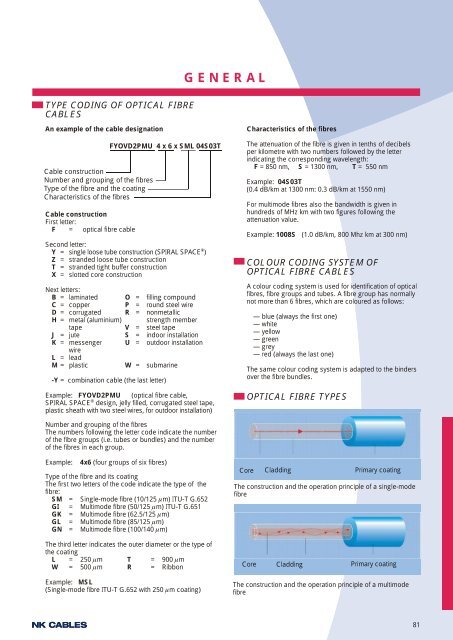Cables for Installations and Industry - Draka
Cables for Installations and Industry - Draka
Cables for Installations and Industry - Draka
You also want an ePaper? Increase the reach of your titles
YUMPU automatically turns print PDFs into web optimized ePapers that Google loves.
TYPE COD ING OF OP TI CAL FI BRE<br />
CA BLES<br />
An ex am ple of the ca ble des ig na tion<br />
Cable construction<br />
Number <strong>and</strong> grouping of the fibres<br />
Type of the fibre <strong>and</strong> the coating<br />
Characteristics of the fibres<br />
Ca ble con struc tion<br />
First let ter:<br />
F = op ti cal fi bre ca ble<br />
FYOVD2PMU 4 x 6 x SML 04S03T<br />
Sec ond let ter:<br />
Y = sin gle loose tube con struc tion (SPI RAL SPACE ® )<br />
Z = str<strong>and</strong>ed loose tube con struc tion<br />
T = str<strong>and</strong>ed tight buffer con struc tion<br />
X = slot ted core con struc tion<br />
Next let ters:<br />
B = laminated O = filling compound<br />
C = copper P = round steel wire<br />
D = corrugated R = nonmetallic<br />
H = metal (aluminium) strength member<br />
tape V = steel tape<br />
J = jute S = indoor installation<br />
K = messenger U = outdoor installation<br />
wire<br />
L = lead<br />
M = plastic W = submarine<br />
-Y = combination cable (the last letter)<br />
Ex am ple: FYOVD2PMU (op ti cal fi bre ca ble,<br />
SPI RAL SPACE ® de sign, jelly filled, cor ru gated steel tape,<br />
plas tic sheath with two steel wires, <strong>for</strong> out door in stal la tion)<br />
Num ber <strong>and</strong> group ing of the fi bres<br />
The num bers fol low ing the let ter code in di cate the number<br />
of the fi bre groups (i.e. tubes or bun dles) <strong>and</strong> the number<br />
of the fi bres in each group.<br />
Ex am ple: 4x6 (four groups of six fi bres)<br />
Type of the fi bre <strong>and</strong> its coat ing<br />
The first two let ters of the code in di cate the type of the<br />
fi bre:<br />
SM = Single- mode fi bre (10/125 µm) ITU-T G.652<br />
GI = Mul ti mode fi bre (50/125 µm) ITU-T G.651<br />
GK = Mul ti mode fi bre (62.5/125 µm)<br />
GL = Mul ti mode fi bre (85/125 µm)<br />
GN = Mul ti mode fi bre (100/140 µm)<br />
The third let ter in di cates the outer di ame ter or the type of<br />
the coat ing<br />
L = 250 µm T = 900 µm<br />
W = 500 µm R = Rib bon<br />
Ex am ple: MSL<br />
(Single- mode fi bre ITU-T G.652 with 250 µm coat ing)<br />
GENERAL<br />
Char ac ter is tics of the fi bres<br />
The at tenua tion of the fi bre is given in tenths of deci bels<br />
per kilo me tre with two num bers fol lowed by the let ter<br />
in di cat ing the cor re spond ing wave length:<br />
F =850 nm, S =1300 nm, T = 550 nm<br />
Ex am ple: 04S03T<br />
(0.4 dB/km at 1300 nm: 0.3 dB/km at 1550 nm)<br />
For mul ti mode fi bres also the b<strong>and</strong> width is given in<br />
hun dreds of MHz km with two fig ures fol low ing the<br />
at tenua tion value.<br />
Ex am ple: 1008S (1.0 dB/km, 800 Mhz km at 300 nm)<br />
COL OUR COD ING SYS TEM OF<br />
OP TI CAL FI BRE CA BLES<br />
A col our cod ing sys tem is used <strong>for</strong> iden ti fi ca tion of op ti cal<br />
fi bres, fi bre groups <strong>and</strong> tubes. A fi bre group has nor mally<br />
not more than 6 fi bres, which are col oured as fol lows:<br />
— blue (al ways the first one)<br />
— white<br />
— yel low<br />
— green<br />
— grey<br />
— red (al ways the last one)<br />
The same col our cod ing sys tem is adapted to the bind ers<br />
over the fi bre bun dles.<br />
OPTICAL FIBRE TYPES<br />
Core Cladding<br />
Primary coating<br />
The construction <strong>and</strong> the operation principle of a single-mode<br />
fibre<br />
Core Cladding<br />
Primary coating<br />
The construction <strong>and</strong> the operation principle of a multimode<br />
fibre<br />
81





